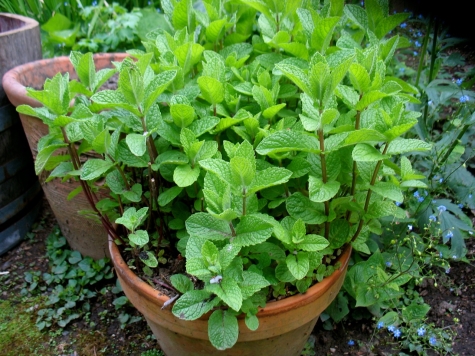It's pretty in the landscape and easy to grow (albeit it's a real-estate hog that needs constant thinning unless you grow it in pots), it is loaded with health benefits, and it tastes absolutely divine! These are the reasons I don't wanna live without peppermint!
While peppermint leaves are available throughout the year, and are especially good in warm weather when they can give a burst of cool flavor to a summery salad or beverage, I use them all year long in all sorts of ways.
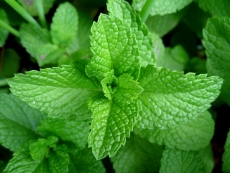 Peppermint has greenish-purple lance-shaped leaves while the rounder leaves of spearmint are more of a grayish green color. The taste of both peppermint and spearmint bear a flavor that can be described as a cross between pepper and chlorophyll, with peppermint being a bit stronger and spearmint being a little more cool and subtle.
Peppermint has greenish-purple lance-shaped leaves while the rounder leaves of spearmint are more of a grayish green color. The taste of both peppermint and spearmint bear a flavor that can be described as a cross between pepper and chlorophyll, with peppermint being a bit stronger and spearmint being a little more cool and subtle.
This tasty plant is LOW in calories and is loaded with vitamins A and C and the mineral manganese. Peppermint is also a very good source of dietary fiber, folate, iron, magnesium, calcium, and vitamin B2 (based on its few calories and high nutrient density). Finally peppermint is a good source of omega-3 fatty acids, potassium, and copper.
It's this nutrition power-pack that makes peppermint so effective as:
- a tummy soother. The oils in peppermint relieve symptoms of irritable bowel syndrome, including indigestion, dyspepsia, and colonic muscle spasms. I make fresh peppermint leaf tea every evening—it's calming and makes sleep easier.
- an anti-cancer agent. Perillyl alcohol is a phytonutrient called a monoterpene, and it is plentiful in peppermint oil. Research shows it stops the growth of pancreatic, mammary, and liver tumors. It has also been shown to protect against cancer formation in the colon, skin, and lungs.
- an anti-microbial oil. Esssential oil of peppermint also stops the growth of many different bacteria. These bacteria include Helicobacter pylori, Salmonella enteritidis, Escherichia coli O157:H7, and methicillin-resistant Staphylococcus aureus (MRSA). It also inhibits the growth of certain types of fungus. I add 20 drops of peppermint essential oil with 20 drops of grapefruit seed extract (GFS) to a quart or so of water to make a powerful anti-microbial, anti-fungal cleaner for my kitchen counters and as a bathroom disinfectant. I also add fresh peppermint leaves to my green smoothie each morning.
- an asthma help. You can breathe easier when ingesting and even just smelling peppermint. It contains the substance rosmarinic acid, which is an antioxidant that neutralizes free radicals. Rosmarinic acid blocks the production of pro-inflammatory chemicals, such as leukotrienes. It also encourages cells to make substances called prostacyclins that keep the airways open for easy breathing. Extracts of peppermint have also been shown to help relieve the nasal symptoms of allergic rhinitis (colds related to allergy).
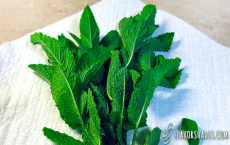 When it comes to buying and storing peppermint, whenever possible, choose fresh mint over the dried form—the flavor of fresh is far superior to the dried. Fresh mint leaves should look vibrant, be a rich green color, and be free from dark spots or yellowing.
When it comes to buying and storing peppermint, whenever possible, choose fresh mint over the dried form—the flavor of fresh is far superior to the dried. Fresh mint leaves should look vibrant, be a rich green color, and be free from dark spots or yellowing.
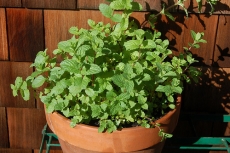 To store fresh mint, carefully wrap the leaves in a damp paper towel and place this inside a loosely closed plastic bag. Store in the refrigerator, where it should keep fresh for several days. Dried mint should be kept in a tightly sealed glass container in a cool, dark, and dry place, where it will keep fresh for about nine to twelve months.
To store fresh mint, carefully wrap the leaves in a damp paper towel and place this inside a loosely closed plastic bag. Store in the refrigerator, where it should keep fresh for several days. Dried mint should be kept in a tightly sealed glass container in a cool, dark, and dry place, where it will keep fresh for about nine to twelve months.
Now a few quick serving ideas:
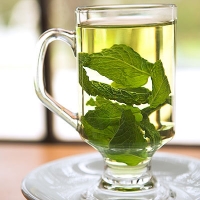 Make fresh mint tea.
Make fresh mint tea.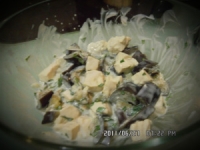 Add chopped mint leaves to cubes of cooked eggplant, plain yogurt, garlic, and cayenne.
Add chopped mint leaves to cubes of cooked eggplant, plain yogurt, garlic, and cayenne.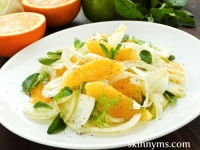 Create a quick and easy salad by combining fennel, onions, oranges, and mint leaves.
Create a quick and easy salad by combining fennel, onions, oranges, and mint leaves.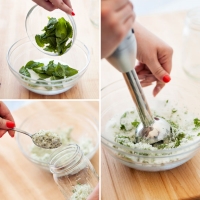 Grind fresh mint into a tablespoon of sugar or xylitol and toss fresh fruit in this as a way to give fruit salad a dazzling perk.
Grind fresh mint into a tablespoon of sugar or xylitol and toss fresh fruit in this as a way to give fruit salad a dazzling perk.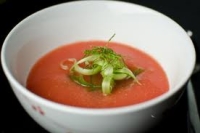 Add chopped mint leaves to gazpacho or other soups that feature tomatoes—the freshness of the mint complements the sweet acidity of tomatoes really well.
Add chopped mint leaves to gazpacho or other soups that feature tomatoes—the freshness of the mint complements the sweet acidity of tomatoes really well.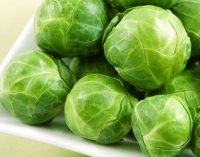 Add mint leaves to Brussels sprouts: chop up a few sprouts, chop some mint leaves-steam together for a few minutes. The mint infuses into the sprouts and the flavor combination is wonderful.
Add mint leaves to Brussels sprouts: chop up a few sprouts, chop some mint leaves-steam together for a few minutes. The mint infuses into the sprouts and the flavor combination is wonderful.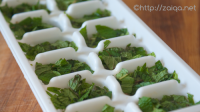 Add chopped mint leaves to your ice cube tray. When cubes are frozen, remove and store in plastic freezer bags. Use cubes throughout the year in your herb teas and other drinks.
Add chopped mint leaves to your ice cube tray. When cubes are frozen, remove and store in plastic freezer bags. Use cubes throughout the year in your herb teas and other drinks.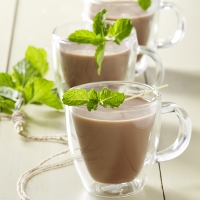 Add lots of chopped mint leaves to hot cocoa—it gives the cocoa a wonderful flavor and, as mentioned above, the leaves make healthy eating!
Add lots of chopped mint leaves to hot cocoa—it gives the cocoa a wonderful flavor and, as mentioned above, the leaves make healthy eating!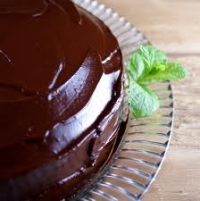 Along the cocoa line, I add chopped mint to my chocolate frostings for cakes, cupcakes, and cookie sandwiches. Same reason: flavor and health punch.
Along the cocoa line, I add chopped mint to my chocolate frostings for cakes, cupcakes, and cookie sandwiches. Same reason: flavor and health punch.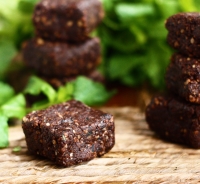 And still along the cocoa line, I add chopped fresh mint to my no-bake cocoa cookie recipe—whether it's drop cookies or formed into little bites (as pictured), the flavor and health boost is too!
And still along the cocoa line, I add chopped fresh mint to my no-bake cocoa cookie recipe—whether it's drop cookies or formed into little bites (as pictured), the flavor and health boost is too!
- www.cookingwithwhatyouhave.com
- www.rbgsocialclub.wordpress.com
- www.flavorshades.com
- www.guiltfreefoodguide.com
- www.thegardenofeating.org
- www.skinnyms.com
- www.covinasjourney.wordpress.com
- www.brit.co
- www.demeterclarc.com
- www.sflfoodswap.wordpress.com
- www.foodfamilyfinds.com
- www.zaiqa.net
- www.allfoodeverything.blogspot.com
- www.meals.com
- www.pattysfood.com
- www.culinaryadventuresinthekitchen.com

Alice Osborne
Weekly Newsletter Contributer since 2006

